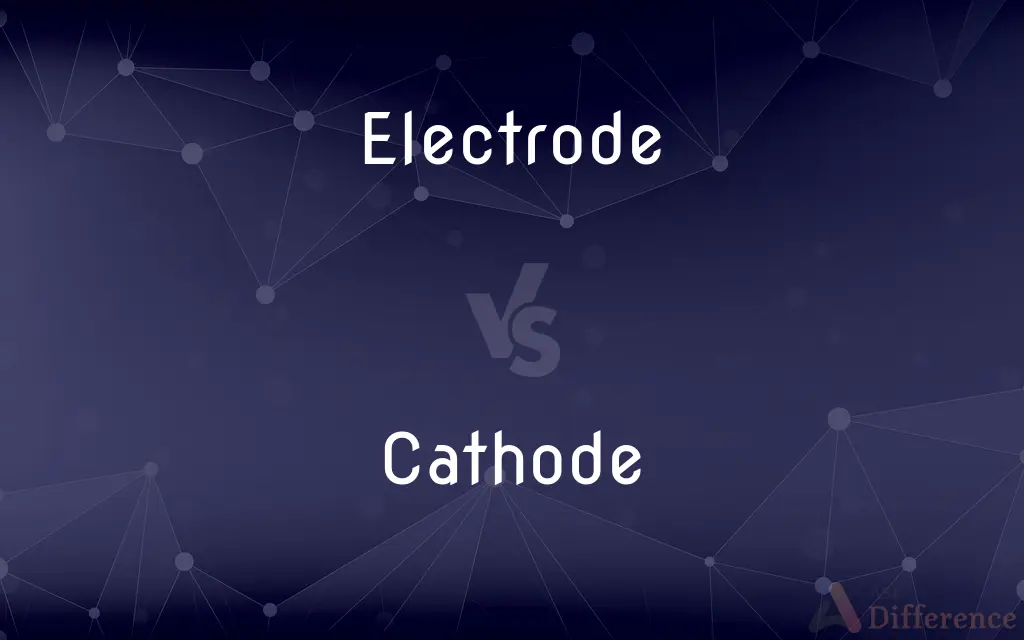Electrode vs. Cathode — What's the Difference?
By Maham Liaqat & Fiza Rafique — Updated on April 6, 2024
An electrode is a conductor through which electricity enters or leaves a medium, while a cathode is a specific type of electrode through which electrons enter a device or a system.

Difference Between Electrode and Cathode
Table of Contents
ADVERTISEMENT
Key Differences
Electrodes serve as the medium for electricity to enter or exit an electrical system, functioning in both the context of electrolytic cells, where chemical reactions are driven by an external voltage, and galvanic cells, which produce electricity through chemical reactions. On the other hand, a cathode is designated as the electrode where reduction occurs in an electrochemical reaction, specifically where electrons are gained, typically associated with the discharge of positive ions.
In an electrolytic cell, the electrode connected to the negative terminal of the power supply is called the cathode because it attracts cations, or positive ions, and facilitates their reduction. Conversely, in a galvanic cell, the cathode is the positive electrode, demonstrating the context-dependent nature of cathode and anode definitions, whereas electrodes maintain their function based on their role in the circuit rather than the type of reaction occurring.
Electrodes are classified based on their material and functionality, such as anodes or cathodes, depending on the direction of current flow relative to the device. Cathodes, being a subset of electrodes, are defined by the specific reaction taking place at their surface, emphasizing the role of electrons and ion flow direction in distinguishing between cathodes and anodes within the broader category of electrodes.
The material composition of electrodes can vary widely, from metals to carbon-based compounds, chosen based on the requirements for conductivity, durability, and chemical reactivity. Cathodes, specifically, are selected for their ability to facilitate electron gain and are often made from materials that are efficient at reducing the ions present in the cell, reflecting their specialized role in the electrochemical process.
While all electrochemical cells require electrodes to function, the designation of an electrode as a cathode is determined by the direction of current flow in relation to the external circuit. This highlights the intrinsic relationship between cathodes and the electrical and chemical processes taking place, showing how cathodes are integral to the function of batteries, electrolytic cells, and other electrochemical systems.
ADVERTISEMENT
Comparison Chart
Definition
Conductor through which electricity enters or exits a medium.
Electrode through which electrons enter a device or system.
Function in Electrochemical Cells
Can act as either anode or cathode depending on the direction of current flow.
Specifically where reduction occurs (gain of electrons).
Relation to Electrical Circuit
Generic term, not specific to the type of reaction.
Defined by the direction of electron flow (into the device or system).
Material Composition
Varies widely based on conductivity, durability, and reactivity needs.
Chosen for ability to facilitate electron gain and reduce ions efficiently.
Context-Dependent Role
Role (anode/cathode) determined by current flow direction relative to the device.
Role is fixed in the context of the electrochemical reaction taking place.
Compare with Definitions
Electrode
A conductor through which electricity enters or leaves a medium.
The experiment used a platinum electrode to ensure minimal reaction interference.
Cathode
Positively charged in galvanic cells.
The cathode is the source of electrons in a chemical reaction that generates electricity.
Electrode
Classified based on their function in the circuit.
The electrode connected to the positive terminal is called the anode in electrolytic cells.
Cathode
Designated based on the direction of electron flow.
The cathode in an LED is where electrons enter the device.
Electrode
Serves as a critical component in electrochemical cells.
Each cell contains two electrodes: an anode and a cathode.
Cathode
Electrode where reduction (gain of electrons) occurs.
In a rechargeable battery, the cathode attracts cations during discharging.
Electrode
Can be made from various materials.
Graphite electrodes are common in high-temperature applications.
Cathode
Specifically attracts cations in an electrochemical reaction.
The cathode in an electrolysis setup reduces metal ions to metal.
Electrode
Integral to both galvanic and electrolytic cells.
Electrodes in a battery facilitate ion flow to generate electricity.
Cathode
Material selection is crucial for its function.
Lithium cobalt oxide is a common cathode material in lithium-ion batteries.
Electrode
An electrode is an electrical conductor used to make contact with a nonmetallic part of a circuit (e.g. a semiconductor, an electrolyte, a vacuum or air).
Cathode
A cathode is the electrode from which a conventional current leaves a polarized electrical device. This definition can be recalled by using the mnemonic CCD for Cathode Current Departs.
Electrode
A solid electric conductor through which an electric current enters or leaves an electrolytic cell or other medium.
Cathode
A negatively charged electrode, as of an electrolytic cell, storage battery, diode, or electron tube.
Electrode
A collector or emitter of electric charge or of electric-charge carriers, as in a semiconducting device.
Cathode
The positively charged terminal of a primary cell or a storage battery that is supplying current.
Electrode
The terminal through which electric current passes between metallic and nonmetallic parts of an electric circuit.
Cathode
(electricity) An electrode, of a cell or other electrically polarized device, through which a positive current of electricity flows outwards (and thus, electrons flow inwards). It usually, but not always, has a positive voltage.
Electrode
A collector or emitter of electric charge in a semiconducting device.
Cathode
The electrode at which chemical reduction of cations takes place, usually resulting in the deposition of metal onto the electrode.
Electrode
A conducting object by which electricity is conveyed into or from a solution or other non-metallic conducting medium; esp., the ends of the wires or conductors, leading from source of electricity, and terminating in the medium traversed by the current.
Cathode
(electronics) The electrode from which electrons are emitted into a vacuum tube or gas-filled tube.
Electrode
A conductor used to make electrical contact with some part of a circuit
Cathode
(electronics) That electrode of a semiconductor device which is connected to the n-type material of a p-n junction.
Cathode
The part of a voltaic battery by which the electric current leaves substances through which it passes, or the surface at which the electric current passes out of the electrolyte; the negative pole; - opposed to anode.
Cathode
A negatively charged electrode that is the source of electrons in an electrical device
Cathode
The positively charged terminal of a voltaic cell or storage battery that supplies current
Common Curiosities
What is the main difference between an electrode and a cathode?
An electrode is a general term for a conductor in an electrical system, while a cathode is specifically an electrode where reduction occurs.
What determines an electrode's role as an anode or cathode?
The direction of current flow relative to the device determines whether an electrode acts as an anode or cathode.
Why is the material of a cathode important?
The cathode material is crucial for its ability to efficiently facilitate electron gain and support the specific reduction reaction occurring.
What advancements are being made in cathode materials?
Research is focusing on developing materials that offer higher energy densities, faster charging, and longer lifespans for batteries.
Can the cathode be both positive and negative?
Yes, the charge of a cathode depends on the type of cell; it's positive in galvanic cells and negative in electrolytic cells.
How does the function of electrodes vary in different applications?
Electrodes can vary in function based on the electrical and chemical processes of the device, serving as points of electrical contact for reactions or power delivery.
Are all cathodes made from the same material?
No, cathode materials vary widely depending on the application, specifically chosen for their reduction capabilities and chemical stability.
How do cathodes contribute to battery life?
The efficiency and chemical properties of cathode materials significantly influence battery capacity, energy density, and longevity.
What are the safety considerations for cathode materials?
Cathode materials must be stable and safe under operational conditions to prevent overheating or unwanted reactions.
Can an electrode switch between being an anode and a cathode?
Yes, in rechargeable batteries, electrodes can switch roles between charging and discharging cycles.
Is the cathode always the source of electrons in a circuit?
In the context of electrochemical cells, the cathode is where electrons are gained (reduction), but in the circuit, it's where electrons enter the system.
How does the role of electrodes differ in electrolytic vs. galvanic cells?
In electrolytic cells, electrodes are powered by an external source, while in galvanic cells, they generate electricity through spontaneous reactions.
Why might different applications require different electrode materials?
Different applications may have unique requirements for conductivity, chemical reactivity, and durability, necessitating specific materials.
How does electrode degradation affect performance?
Degradation can lead to decreased conductivity and efficiency, impacting the overall performance and lifespan of the device.
What role does the cathode play in renewable energy technologies?
Cathodes are key in energy storage solutions like batteries, which are essential for managing and utilizing renewable energy efficiently.
Share Your Discovery

Previous Comparison
Lizard vs. Dragon
Next Comparison
Chip vs. CrispAuthor Spotlight
Written by
Maham LiaqatCo-written by
Fiza RafiqueFiza Rafique is a skilled content writer at AskDifference.com, where she meticulously refines and enhances written pieces. Drawing from her vast editorial expertise, Fiza ensures clarity, accuracy, and precision in every article. Passionate about language, she continually seeks to elevate the quality of content for readers worldwide.














































